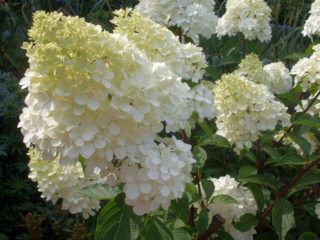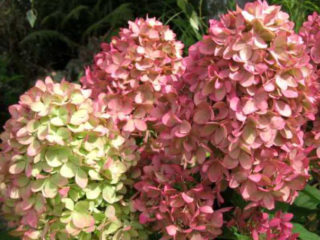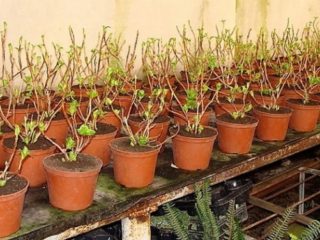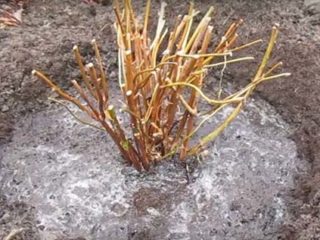Content
One of the most attractive ornamental shrubs for a suburban area is the Sargent hydrangea. Large, rough leaves and delicate purple inflorescences attract the attention of passers-by and emphasize the exquisite taste of the owners of the garden. Receiving proper care, the shrub pleases those around it with a lush crown and abundant flowering for a long time.
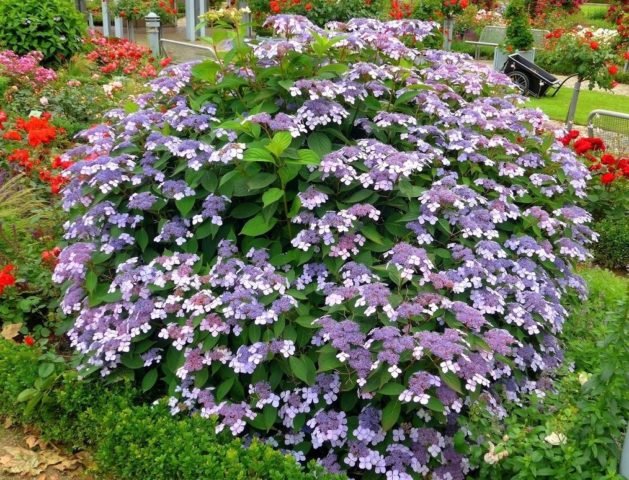
Hydrangea Sargent very poorly tolerates low temperatures
Description of Sargent hydrangea
The name of this hydrangea variety was formed on the basis of the name of the American biologist. Its natural habitats are the forests and valleys of China. Hence the love for partial shade and moist soil. The large frosts characteristic of the climate of the middle zone, the Sargent hydrangea does not tolerate well.
Shoots begin to develop from the end of April, adding 20-30 cm per month. By the end of the growing season (mid-September) Sargent hydrangea reaches 1-1.5 m in height and width. Lilac inflorescences with pale blotches of sterile flowers adorn the bush during the second half of summer until autumn frosts.
A feature of the bush is the unusually long leaves - about 30 cm. They are covered with thick fluff and do not change color until the very death. Young shoots have sparser and coarser pubescence. The bark on lignified branches exfoliates, enhancing the decorative effect.
Hydrangea Sargent in landscape design
In landscape design, Sargent's hydrangea has found wide application. Lush neat bushes can be an accent or complementary element of many landscaping styles. Sargent's rough hydrangea is appreciated for the opportunity to experiment with ideas, because it is almost universal in application.
Features of Sargent hydrangea as a design element:
- In a single planting it focuses on itself due to its high decorative effect.
- Contrasting floral arrangements give tenderness and uniqueness.
- With plantations of coniferous and deciduous shrubs, it forms a complete picture.
- Alleys and hedges are extraordinarily spectacular.
- It is in perfect harmony with the lower plants in the mixborder.
- Looks graceful in container fit.
Winter hardiness of hydrangea rough Sargent
The frost resistance zone of Sargent's hydrangea is 6a. This means that the minimum temperature at which it is able to remain viable is 23 ° C. But even in these regions, a shelter is being prepared for the plant.
In winter, the ground part of the plant partially or completely dies off. During the growing season, young shoots have time to gain the required length. The probability that inflorescences will appear on them is high. To increase the likelihood of flowering, gardeners carefully insulate the bush for the winter.
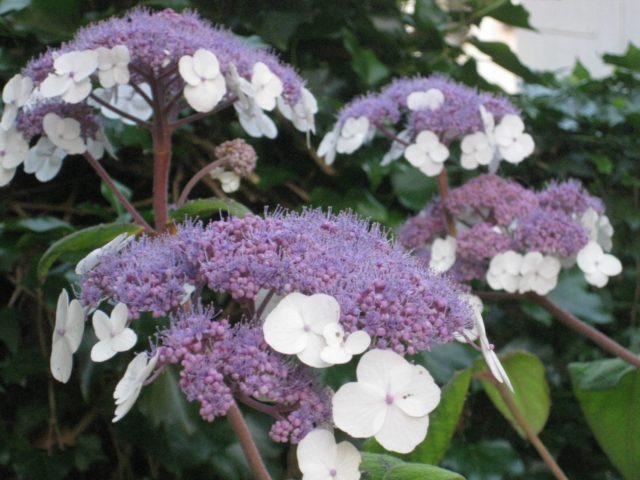
For the winter, the bushes of the plant need to be insulated
Planting and caring for Sargent hydrangea
In order for Sargent's hydrangea to be lush, not sick and bloom profusely, it is necessary to create suitable conditions for it.
The following factors are of great importance:
- soil composition;
- illumination;
- moisture content;
- temperature in winter.
Growing a plant from a different climatic zone forces you to especially strictly follow the rules of planting and care.
Selection and preparation of the landing site
When choosing a place for planting Sargent's hydrangea, take into account its basic needs:
- Moderate sun.
- Sour and light soil.
- Lack of winds.
Exposure to the bush in direct sunlight in the middle of the day leads to leaf burns. Therefore, the location has to be thought out so that at noon the bush is in the shade or partial shade. Full sun protection will disrupt cultural development. Hydrangea Sargent is not able to fully take root in the soil typical of steppe regions. In other words, it is not satisfied with alkaline, heavy and infertile soil.
Landing rules
Saplings at the age of 2-3 years take root best of all. Planting is usually done before the buds are completely blooming or after the leaves have fallen, following the following pattern:
- Dig a hole 40x40x50 in size.
- Spread on the bottom a drainage layer up to 10 cm from broken brick or gravel.
- Pour 10-15 cm of fertile soil on top.
- The roots of the seedling are spread and buried to the root collar.
- Water the planting site with plenty of water.
- The trunk circle is mulched.
Planting a seedling with closed roots is permissible at any period from the beginning to the end of the growing season. During the hot season, he needs to create a temporary shelter from the sun.
Watering and feeding
Hydrangea Sargent needs abundant regular watering. During the growing season, they should be at least 5. When watering, it is important to take into account the peculiarity of the location of the roots - they are shallow, but grow in breadth. To slow down the evaporation of moisture, loosening the soil is carried out.
To increase the decorativeness of the culture, top dressing is carried out. The first is at the beginning of the season, then 2-3 times during the summer. It is especially important to apply fertilizers during the budding period. Hydrangea Sargent is susceptible to organic and mineral fertilizing.
Pruning Sargent hydrangea
Annual pruning of the bush is carried out for the following purposes: maintaining health, forming a lush crown, abundant flowering and rejuvenation of the bush. In cold regions, the event is held in the fall before the shelter for the winter. Most of the shoot length is removed.
In warmer regions, pruning may be delayed until early spring. Gardeners wait for the emergence of sprout buds and leave 3-4 of them on each shoot. Annual pruning includes a sanitary part: cutting diseased and crooked branches.
Preparing for winter
To protect against temperature extremes and severe frosts in the absence of snow, Sargent's hydrangea is covered for the winter. They do it according to the following scheme:
- Huddle the base of the bush.
- Mulch the soil with dry leaves.
- Constructing a shelter.
For shelter, use cardboard boxes, thick paper or agrofiber. Old bushes are protected with a layer of foliage or spruce branches, which is fixed with a metal frame.
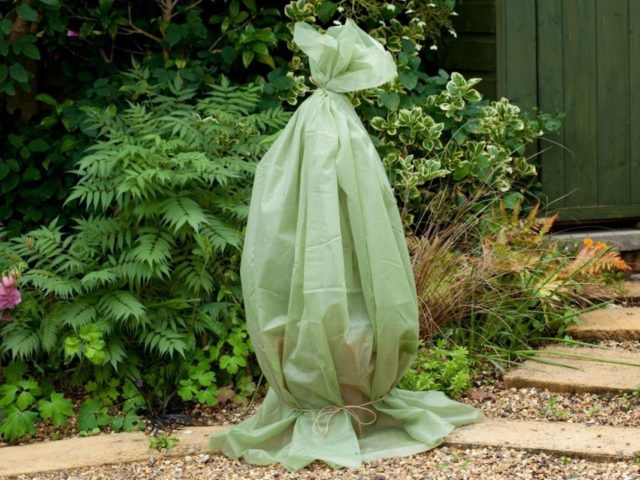
Shelter protects the bush during frosty periods without snow
Reproduction
There are three effective ways to propagate Sargent hydrangea:
- Division of bushes.
- The formation of layering.
- Cuttings.
Propagation by cuttings is the most common option. The blanks are made in the summer during the budding period. The formation of layering and division of the bush is carried out in early spring before bud break.
Diseases and pests
With a sufficient amount of moisture and minerals, moderate lighting, light acidic soil and proper preparation for winter, the chances of the appearance of the disease become minimal. In rare cases, white or gray rot, common cancer, chlorosis, powdery mildew, various types of spotting, bark necrosis appear.
Sometimes the rough hydrangea bushes are attacked by a tick, aphid, a bug, a scoop, a gall nematode, a golden bronze, a leaf beetle and an earwig.The problem is easily eliminated by spraying with suitable insecticides.
Conclusion
Hydrangea Sargent is suitable for the embodiment of many ideas in landscape design. It looks spectacular in single and group planting, during and before flowering. However, to preserve the high decorativeness of the culture, it is necessary to create optimal conditions for it.
The full development of hydrangea occurs only in light acidic soil. To maintain the health of the bush, regular watering, annual pruning and shelter for the winter are required. High-quality feeding gives the plant the necessary elements for rapid growth and abundant flowering. If diseases or pests are detected, action should be taken immediately.
Reviews of hydrangea rough Sargent
Gardeners willingly share their impressions of the cultivation of Hydrangea Sargent. In most cases, the reviews are positive.
Hydrangea Sargent is famous for its high decorativeness, therefore it becomes an invariable attribute of many gardens. Although the culture is accustomed to the wet forests of China, it has adapted well to drier and colder conditions. Every spring, many young shoots soar upward to create a lush crown to decorate the garden.

